Opal is my big white Delaware hen. The Delaware is a classic, fat hen with a docile temperament. The breed was developed in the 1940s as a meat chicken, so I didn’t expect a lot of eggs from Opal, I just like her looks and personality. That’s why it’s such a surprise that she’s the only Gem who is presently laying. This is especially remarkable because she’s the hen whose eggs were most affected by IB (infectious bronchitis). Even today, with the flock recovered, she continues to lay wrinkled eggs. Her eggshells have creases., but she lays almost daily. In fact, Opal has yet to go through a molt.
Other hens are on the worst dressed list. When Amber stretches her head up, her scrawny red neck shows, and she looks like she’s wearing a moth-eaten sweater.
The molt is not an orderly, controllable event. It’s affected by genetics, health, weather, and a multitude of other inputs. Two hens of the same breeding and age, living together, can experience the molt in vastly different ways. Here is Ruby. She is not a very good layer, and in October she molted and quickly regrew her feathers.
Her sister, Garnet, who is the better layer of the two, has been dropping her feathers in clumps, and is regrowing them in a dramatic, imitate a porcupine, manner.
Notice the Onyx, the Barnevelder hen, has molted and has replenished her lovely feathers, which to my eye, always looks like the finest of Scottish tweed coats.
You might think, seeing these photos, that the poorest layers molt first. That’s generally true, but there’s always exceptions. Edwina is 8 1/2 years old. She hasn’t laid an egg for years. Edwina hasn’t molted yet. I honestly don’t know if she will. There’s nothing in my books, vintage, nor modern, about the molting habits of ancient hens. Edwina certainly looks good, doesn’t she?
Other old hens of mine have molted. Buffy is slowly, slowly regrowing her feathers. Twinkydink went through a light molt, hardly noticeable if you didn’t know her well. Betsy has molted and is still getting her new quills in.
Meanwhile, what with the cold and the reduced daylight, I don’t expect to see eggs from the Gems until February. Unless, that is, Opal never does molt and continues, every day, to leave this in the nesting box.
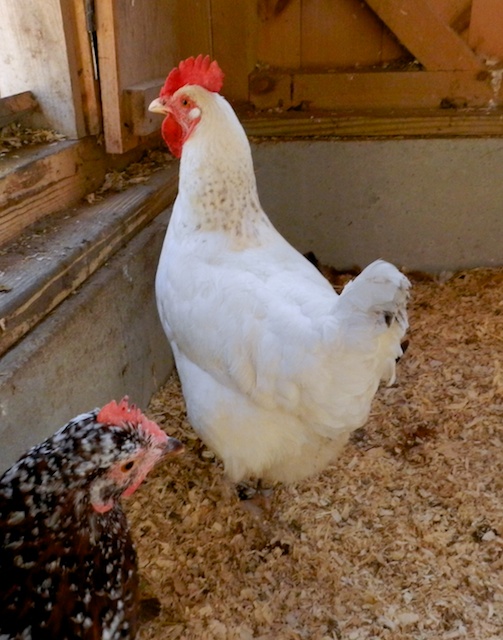

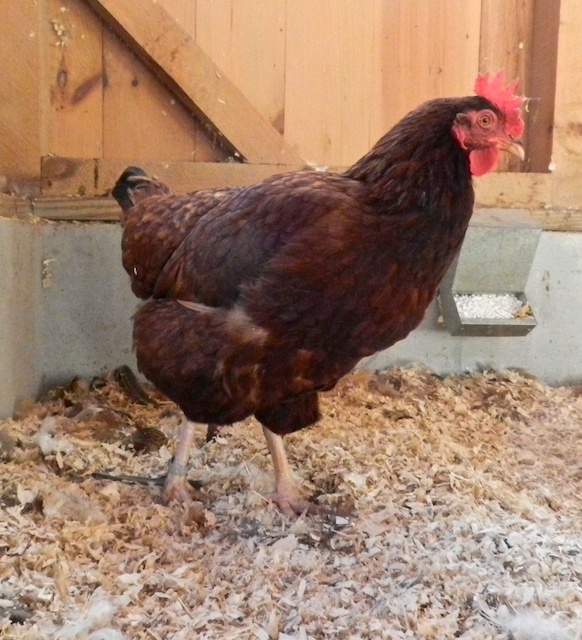
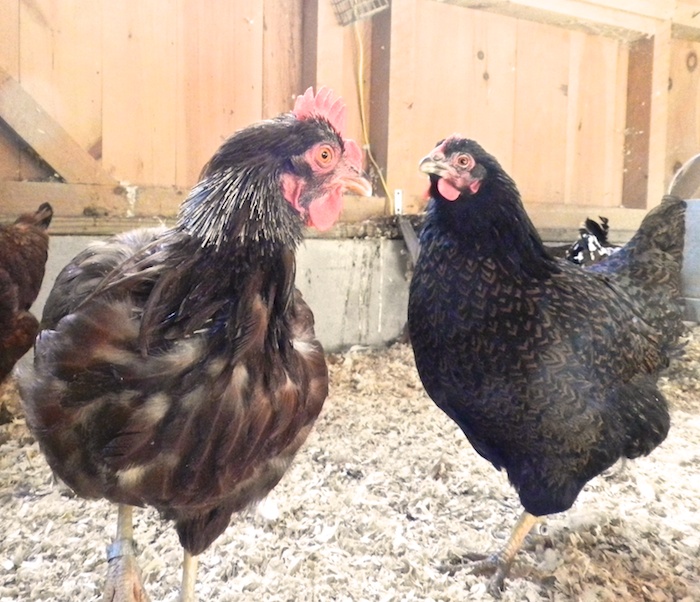
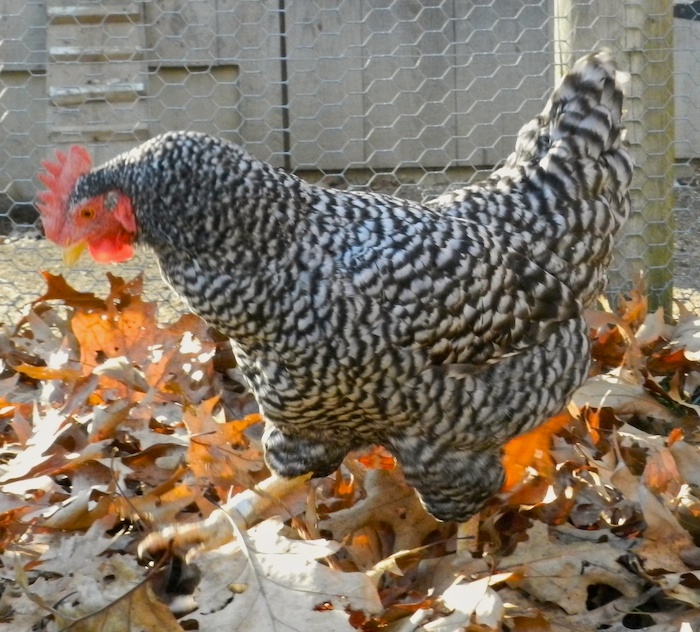
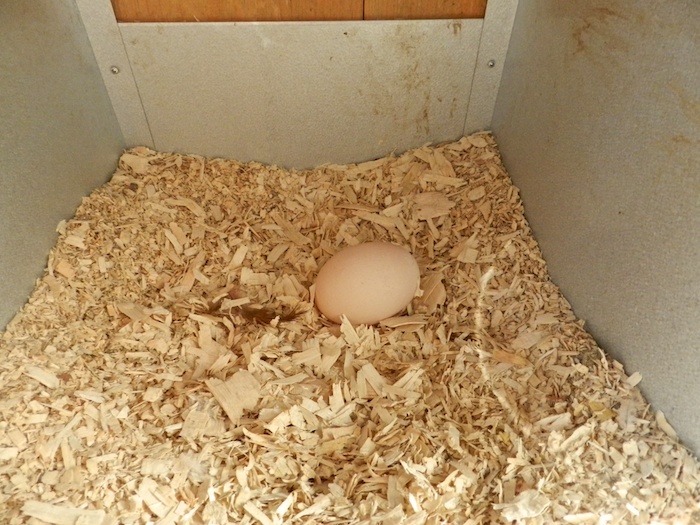

Ha, Amber looks just like my buff Orp, Betty does right now. And it’s snowing today, so she’d better get a wiggle on and grow those feathers!
Poor Garnet, she does look like a porcupine! I would love to see her feather growing progress, could you periodically take pictures of the process for non chicken keepers like myself.
Do the chickens preen each other to get the pinnies out?
No, they don’t preen each other. My hen, Snowball, liked it when I scratched her head, but that’s rare among chickens.
It’s called allopreening, and mostly seen in parrot species. I wish our domesicating of red/grey jungle fowl into chickens had introduced this. Chickens would feel so much better, because our hands could do two at once. Terry’s Snowball and one rooster on youtube are only the chickens I have ever heard of that would allow and loved for their owner to gently rub off the keratin sheath. I am sure if Terry bent over and touched one quill on Garnet or Pearl then they would probably scream blood murder and run off.
Garnet looks like she is wearing a very avant garde scarf. But Onyx is a real knockout. Gorgeous feathers and that imperious look that reminds me of Candy.
Is it normal for a hen to keep laying while moulting? My Brown Boven hen is just a laying machine…never seems to take a day off despite doing a long drawn out moult. The Orpington is also laying but I don`t think she is moulting yet. She was late to mature so I figure she is just not ready yet? And my Campine finished her moult a month ago and has not started to lay again. Is she likely to wait until Spring do you think? Are wrinkly eggs always a sign of problems? My oldest hen(mixed breed ), who is around 3 yrs., had been laying very odd shaped wrinkly eggs for a while but does not show any other signs anything is amiss. She is moulting now so is not presently laying.
It is not normal for a hen to keep laying during molt, but it does happen, especially with the hybrids that are designed to lay daily. Although your hens might look like they are out of the molt, it can take a full 10 weeks from start to finish. Since the molt usually coincides with cold temps and decreased light, the hens take a break until February. Wrinkly eggs are always a sign that something is amiss, but the problem might not cause further health issues.
Thank-you for clearing up my current questions. It becomes more obvious that hens have a tough life. You sure would not know it by listening to their happy chirps and watching them busily scratching in the garden with each other. I miss the eggs but am so glad they get respite…except Mae, poor hen. She is like people I know that are happy never to properly retire.
I saw on a Martha Stewart clip that she had a featherless chicken. It froze in winter. I was wondering Terry if you do anything to keep the girls warm, while molting, in cold weather? I have a small coop with adequate ventilation. I hope it’s enough to keep them from freezing during a molt. Any responses from you would be appreciated.
No heat needed. As long as they have a dry and draft-free coop, your hens will be fine.
Thanks!
Onyx is beautiful. And Edwina looks great. I have a hen, Flower, that lays wrinkly eggs . But she is the only one that does. She had a traumatic experience ths past spring. Long story but her comb was hanging off and bleeding and we had to remove a part of it. She s a Wyandotte but has continued laying until last week when she started molting. I haven’t seen anyone else with wrinkled eggs. So if she has or had IB guess she is ok at this point. I ave not seen any indication that anyone else may have it. Thanks for the info about the molt. This is my first .
Are Opal’s eggs safe to consume at this time? I too think Onyx is just beautiful. Barnevelder is a breed I would like to have. I LOVE the video of her ‘talking.’
Yes, totally safe, and I’m grateful for them during this slow production period.